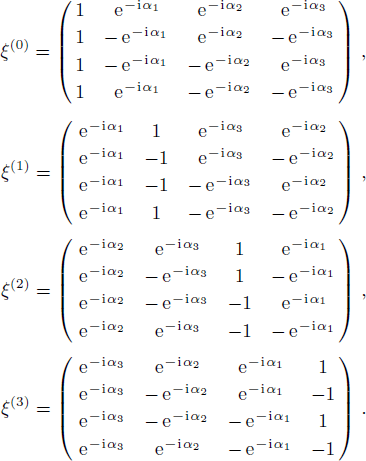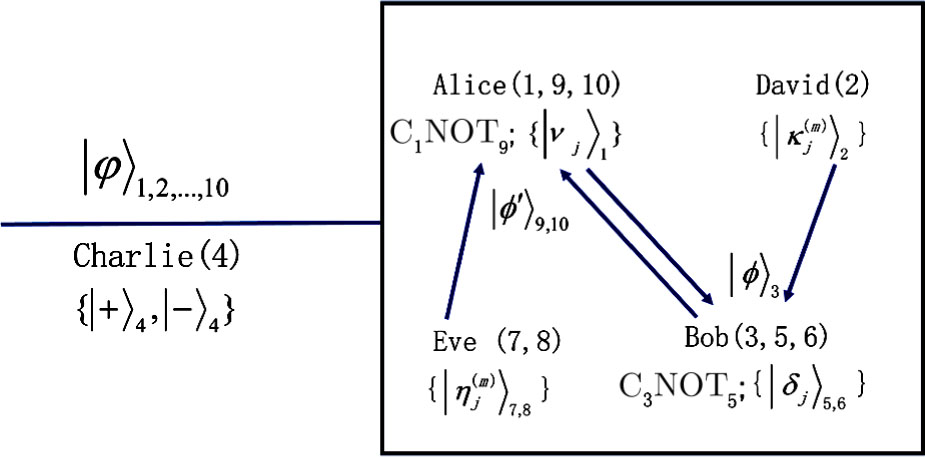† Corresponding author. E-mail:
Supported by the National Natural Science Foundation of China under Grant No. 11604115
The scheme for asymmetric and deterministic controlled bidirectional joint remote state preparation by using one ten-qubit entangled state as the quantum channel is proposed. In this scheme, Alice and David want to remotely prepare an arbitrary single-qubit state at Bob’s site, at the same time, Bob and Eve wish to help Alice remotely prepare an arbitrary two-qubit entangled state. Alice and Bob can simultaneously prepare the desired states with the cooperation of David and Eve under the control of Charlie.
As the carrier of information, quantum states are easily intercepted or replaced by eavesdroppers when direct transmission. Quantum teleportation (QT)[1] and remote state preparation (RSP)[2–4] are two important techniques for transferring information in quantum communication. Based on quantum entanglement, many QT and RSP schemes can be realized via local operations and classical communication. Different from QT protocols, the prepared state is completely known to the sender in RSP schemes. RSP can consume less resources than QT, especially for reconstructing large quantum states. RSP protocols are widely used in quantum information. Various theoretical and experimental RSP schemes[5–16] have been proposed.
In order to avoid the combination of information concentrated on one person, joint remote state preparation (JRSP) schemes [17–37] have been put forward. Each of senders knows partly the state to be prepared in JRSP, which is a secure method for transmitting quantum state. Deterministic joint remote state preparation is that the total successful probability reaches 100%.[32–37] Recently, as the new type of quantum communication schemes, bidirectional RSP schemes include symmetric bidirectional RSP[38–41] and asymmetric bidirectional RSP[42–46] have been proposed. The schemes of controlled bidirectional RSP (CBRSP) were presented.[47–48] The distant collaborators can simultaneously prepare the desired states with permission of the controller in CBRSP protocols.
In this paper, a novel scheme for asymmetric and deterministic controlled bidirectional JRSP (CBJRSP) is proposed by using one ten-qubit entangled state as the quantum channel. In our asymmetric and deterministic CBJRSP scheme, Alice and David wish to remotely prepare an arbitrary single-qubit state at distant Bob’s site, meanwhile, Bob and Eve want to remotely prepare an arbitrary two-qubit state at distant Alice’s site under the control of the supervisor Charlie. It is shown that, only if the controller Charlie agrees to collaborate with four senders, they can remotely prepare the desired states by means of some appropriate basis vectors measurement and unitary operations.
Since bidirectional QT schemes and bidirectional JRSP schemes by using multi-qubit entangled state have been reported in many papers, we try to propose the scheme for asymmetric and deterministic CBJRSP by using one ten-qubit entangled state as the quantum channel in this section. Suppose Alice and David wish to help Bob remotely prepare an arbitrary one-qubit state |ϕ⟩, at the same time, Bob and Eve wish to help Alice remotely prepare an arbitrary two-qubit state |ϕ′⟩ under the control of Charlie.



The state |φ⟩1,2,···,10 can be rewritten as


















Suppose the measuring results are |+⟩4, |ν0⟩1, 




| Table 1. The measuring results and operations of Alice and Bob, the measuring results of David and Eve. . |
In summary, by using basis vectors measurement, controlled not gate operation, controlled σz gate operation, and appropriate unitary transformations, the new scheme for asymmetric and deterministic CBJRSP is proposed. In this scheme, Alice and David remotely prepare an arbitrary single-qubit state at distant Bob’s site. Meanwhile, Bob and Eve remotely prepare an arbitrary two-qubit state at distant Alice’s site under the control of Charlie. Our CBJRSP process can be divided into two JRSP processes with only one controller. Different from former controlled JRSP schemes, the asymmetric and deterministic CBJRSP scheme proposed in this paper has higher efficiency and lower resource costs. The asymmetric and deterministic CBJRSP scheme herein has many potential applications in the field of quantum information. For example, in our asymmetric and deterministic CBJRSP scheme, Alice and Bob can exchange their quantum states simultaneously with the cooperators under the controller Charlie, which can realize long-distance safe transmission of information. Similarly, the asymmetric and deterministic CBJRSP scheme can be extended to CBJRSP of N (N > 2) different M-qubit (M > 2) quantum states. Multi-party exchange their quantum states at the same time with the cooperators under the controller, which can be applied in the quantum internet. Compared with other bidirectional JRSP protocols, our scheme is more secret. We have provided a new way to construct safer quantum channel for quantum secure communication.
| [1] | |
| [2] | |
| [3] | |
| [4] | |
| [5] | |
| [6] | |
| [7] | |
| [8] | |
| [9] | |
| [10] | |
| [11] | |
| [12] | |
| [13] | |
| [14] | |
| [15] | |
| [16] | |
| [17] | |
| [18] | |
| [19] | |
| [20] | |
| [21] | |
| [22] | |
| [23] | |
| [24] | |
| [25] | |
| [26] | |
| [27] | |
| [28] | |
| [29] | |
| [30] | |
| [31] | |
| [32] | |
| [33] | |
| [34] | |
| [35] | |
| [36] | |
| [37] | |
| [38] | |
| [39] | |
| [40] | |
| [41] | |
| [42] | |
| [43] | |
| [44] | |
| [45] | |
| [46] | |
| [47] | |
| [48] |


































































































































